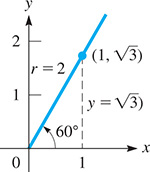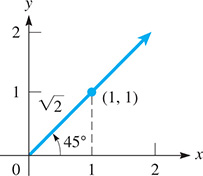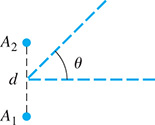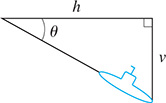4.3 Values of the Trigonometric Functions
Function Values Using Geometry • Function Values from Calculator • Inverse Trigonometric Functions • Accuracy of Trigonometric Functions • Reciprocal Functions
We often need values of the trigonometric functions for angles measured in degrees. One way to find some of these values for particular angles is to use certain basic facts from geometry. This is illustrated in the next two examples.
EXAMPLE 1 Function values of 30 ° and 60 °
From geometry, we find that in a right triangle, the side opposite a angle is one-half of the hypotenuse. Therefore, in Fig. 4.18, letting and and using the Pythagorean theorem, Now with and

Fig. 4.18
Using this same method, we find the functions of to be (see Fig. 4.19)

Fig. 4.19
EXAMPLE 2 Function values of 45 °
Find , , and .
If we place an isosceles right triangle with one of its angles in standard position and hypotenuse along the radius vector (see Fig. 4.20), the terminal side passes through (1, 1), since the legs of the triangle are equal. Using this point, and Thus,

Fig. 4.20
In Examples 1 and 2, we have given exact values. Decimal approximations are also given in the following table that summarizes the results for , , and .
| (exact values) | (decimal approximations) | |||||
|---|---|---|---|---|---|---|
| 0.500 | 0.707 | 0.866 | ||||
| 0.866 | 0.707 | 0.500 | ||||
| 1 | 0.577 | 1.000 | 1.732 | |||
Another way to find values of the functions is to use a scale drawing. Measure the angle with a protractor, then measure directly the values of x, y, and r for some point on the terminal side, and finally use the proper ratios to evaluate the functions. However, this method is only approximate, and geometric methods work only for a limited number of angles. As it turns out, it is possible to find these values to any required accuracy through more advanced methods (using calculus and what are known as power series).
Values of and are programmed into graphing calculators. For the remainder of this chapter, be sure that your calculator is set for degrees (not radians). The following examples illustrate using a calculator to find trigonometric values.
EXAMPLE 3 Values from calculator
Using a calculator to find the value of , first enter the function and then the angle, just as it is written. The resulting display is shown in Fig. 4.21.

Fig. 4.21
Therefore,
Not only are we able to find values of the trigonometric functions if we know the angle, but we can also find the angle if we know that value of a function. In doing this, we are actually using another important type of mathematical function, an inverse trigonometric function. They are discussed in detail in Chapter 20. For the purpose of using a calculator at this point, it is sufficient to recognize and understand the notation that is used.
The notation for “the angle whose sine is x” is This is called the inverse sine function. Equivalent meanings are given to (the angle whose cosine is x) and (the angle whose tangent is x).
CAUTION
Carefully note that the used with a trigonometric function in this way shows an inverse trigonometric function and is not a negative exponent ( represents an angle, not a function of an angle).
On a calculator, the key (usually obtained by pressing ![]() ) is used to find the angle when the sine of that angle is known. The following example illustrates the use of the similar key.
) is used to find the angle when the sine of that angle is known. The following example illustrates the use of the similar key.
EXAMPLE 4 Inverse function value from calculator
If which means that ( is the angle whose cosine is 0.3527), we can use a calculator to find The display is shown in Fig. 4.22.

Fig. 4.22
Therefore, (rounded off).
When using the trigonometric functions, the angle is often approximate. Angles of , , and are angles with equal accuracy, which shows that the accuracy of an angle does not depend on the number of digits shown. The measurement of an angle and the accuracy of its trigonometric functions are shown in Table 4.1:
Table 4.1 Angles and Accuracy of Trigonometric Functions
| Measurements of Angle to Nearest | Accuracy of Trigonometric Function |
|---|---|
| 2 significant digits | |
| or | 3 significant digits |
| or | 4 significant digits |
We rounded off the result in Example 4 according to this table.
Although we can usually set up the solution of a problem in terms of the sine, cosine, or tangent, there are times when a value of the cotangent, secant, or cosecant is used. We now show how values of these functions are found on a calculator.
NOTE
[Because the reciprocal of x equals we can use the key along with the sin, cos, and tan keys, to find the values of and ]
From the definitions, and This means the value of is the reciprocal of the value of Again, using the definitions, we find that the value of is the reciprocal of and the value of is the reciprocal of
EXAMPLE 5 Reciprocal functions value from calculator
To find the value of , we use the fact that
Either of the above two options can be evaluated on a calculator to obtain the result 1.131, which has been rounded according to Table 4.1.
EXAMPLE 6 Given a function—find θ
To find the value of if we use the fact that
Therefore, (rounded off).
EXAMPLE 7 Given one function—find another
Find if
Since the value of is given, we know that This in turn tells us that (extra significant digits are retained since this is an intermediate step).
Therefore, (see Fig. 4.23).

Fig. 4.23
The following example illustrates the use of the value of a trigonometric function in an applied problem. We consider various types of applications later in the chapter.
EXAMPLE 8 Evaluating cosine—rocket velocity
When a rocket is launched, its horizontal velocity is related to the velocity v with which it is fired by the equation Here, is the angle between the horizontal and the direction in which it is fired (see Fig. 4.24). Find if and

Fig. 4.24
Substituting the given values of v and in we have
Therefore, the horizontal velocity is 1010 m/s (rounded off).
EXERCISES 4.3
In Exercises 1–4, make the given changes in the indicated examples of this section and then find the indicated values.
In Example 4, change to and then find the angle.
In Example 5, change to and then find the value.
In Example 6, change 0.354 to 0.345 and then find the angle.
In Example 7, change to and then find the value.
In Exercises 5–20, find the values of the trigonometric functions. Round off results according to Table 4.1.
In Exercises 21–36, find for each of the given trigonometric functions. Round off results according to Table 4.1.
In Exercises 37–40, use a protractor to draw the given angle. Measure off 10 units (centimeters are convenient) along the radius vector. Then measure the corresponding values of x and y. From these values, determine the trigonometric functions of the angle.
In Exercises 41–44, use a calculator to verify the given relationships or statements.
![]() In Exercises 45–50, explain why the given statements are true for an acute angle .
In Exercises 45–50, explain why the given statements are true for an acute angle .
is always between 0 and 1.
can equal any positive real number.
decreases in value as increases from to .
The value of is never less than 1.
if is acute.
If
In Exercises 51–54, find the values of the indicated trigonometric functions if is an acute angle.
Find given
Find given
Find given
Find given
In Exercises 55–60, solve the given problems.
According to Snell’s law, if a ray of light passes from air into water with an angle of incidence of , then the angle of refraction is given by the equation Find
If the backup camera on a car is mounted at a height h above the road and is angled downward (from the horizontal) at an angle then the distance x along the road between the car and the point at which the camera is directed is given by Find x if and
A brace is used in the structure shown in Fig. 4.25. Its length is Find l if and

Fig. 4.25
The sound produced by a jet engine was measured at a distance of 100 m in all directions. The loudness d of the sound (in decibels) was found to be where the line was directed in front of the engine. Calculate d for
The signal from an AM radio station with two antennas d meters apart has a wavelength (in m). The intensity of the signal depends on the angle as shown in Fig. 4.26. An angle of minimum intensity is given by Find if and

Fig. 4.26
A submarine dives such that the horizontal distance h it moves and the vertical distance v it dives are related by Here, is the angle of the dive, as shown in Fig. 4.27. Find if and

Fig. 4.27
Answers to Practice Exercises
0.216
0.664
